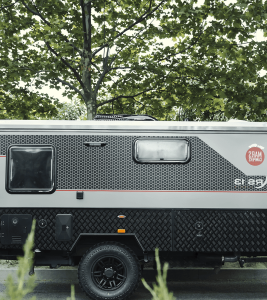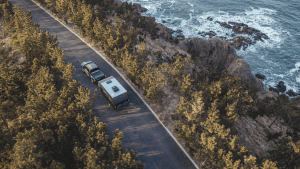I will review some maintenance tips here when you store your camper, whether a camper trailer or a Caravan. I don’t like camping in the summer. Fit’s easier to get warm than cool down, especially in a camp trailer without access to an aircon. So this is stored through 3–4 months of the year.

Don’t do what most people do—back their van away, store it out of the sun, particularly in this area, and expect when next winter comes to jump in it, go off camping, and not expect to have any problems. A bit of maintenance tips, and particularly for use with camper trailers:
Once a month, I hook my camper trailer up. I store mine in the garage. I’m lucky enough to have a big enough garage where I can store it inside, and I open it up. This is a canvas. Particularly if you live in an environment as we do in Australia, where it’s very humid, particularly up here where I live in central Queensland—extreme humidity—you’ve got to make sure you combat one of the worst enemies of canvas: mould.
So, to do that, you always want to pack it away when it’s dry. Make sure it’s completely dry. Now, if you’re travelling on the road and it’s raining, you pack it up—that’s all fine, as long as when you get home, you open it. Even if it’s still raining, it’s fine. There have been times I’ve come home, and I had to leave this set up outside in the backyard for a few days before it would dry out because it’s just continuous rain. That’s fine. It’s a good-quality canvas nowadays. They use it in many of these camper vans, and they can handle it.

What they can’t handle is being stored wet. So that’s the first tip: make sure it’s completely dry before you pack it away. You come home, pack it away, and leave it out the front or in your garage.
Next Step: Don’t leave it there for 3–4 months and then hook it up, go away camping, and expect it to be new. There’s a good chance you’ll have mould, and then you have to clean the mould off. Now, some chemicals out there do a good job of cleaning the mould.
Once a month, I set this up for about 2 or 3 days to air out. I go over, check the canvas, ensure it’s clean, and give it a clean. I clean the camper trailer.
And if you recall, I’ve got a diesel heater in this. Then what I do is I run the diesel heater once a month for 30 minutes at 100% max. That will then guarantee that the next time you go away camping in winter, you will turn that diesel heater on, and it will work flawlessly. If you do not do that if you leave that diesel in that diesel heater for months and months and months before you use it, it’s going to turn sludgy, and it’s just going to block everything up. Then you’ll have to replace all the fuel lines, your fuel pump, the whole works, and clean that diesel heater out—a quite big job—before you can start using that again.
But running it for half an hour per month will keep a fresh supply of clean fuel. And in fact, I will do that right now because it’s been almost 4 weeks. Very easy to do.
Mine, I’ve got the control here. I’ll go here—power on. Power on. That’s it. I’ve got that set at maximum speed already, and I’ll leave it at that. That will fire up. I’ll come back in half an hour and turn that off. Power off. So as simple as that. You saw how easy it is, and that will save you much heartache. Believe me, I know. There’s a lot of you out there with diesel heaters. So, if you haven’t run it since last winter, get it out and do what I just did. You’re going to thank me for it next winter.
Another Thing I Do: Hot Water Systems
A lot of you have hot water. Now, I have two tanks in my camper trailer. I have a 120L stainless steel tank under the bottom and an 80L tank at the back—so 200L of water I can store in here.
Some store them empty; some store them full. I store it fully. I make sure it’s full right to the top. Also, during the off-season, I use some chemicals such as Camco, whatever you call it, and I clean all the tanks out and flush them about 3 or 4 times. Then I fill it up and store it full.
You can hear the diesel heater just firing up now. You want to recycle some of that water occasionally because you have pipelines in your camper vans and caravans. You don’t want that water to sit there for 3–4 months or 6 months that you’re not camping. I turn the pump on, turn the hot water system on, and run the hot water system at maximum temp, which, in my case, luckily enough, is close to 70°C, which is hot enough to decontaminate it.
It goes a long way to keeping it healthy. Mine has a hot water tank that stores 10L of water and is always full. I always make sure that it is full. I will turn that hot water system on shortly and bring that water up to that high 70°C.
If it’s at 70°C for at least 10 minutes, that will sterilize and help keep it clean. But not only that, I suggest going through your camper van, and turning on all the taps. Once that water is nice and hot, turn the hot water taps on and get that hot water cycling through your plumbing—clean and decontaminated.
If you do that once a month, your water supply will be nice and clean.
Other Maintenance Checks:
You can hear the diesel heater running now. It’s running at full ball—100% max. Even in the coldest weather with icicles dripping down, you never run that at 100% max. These things work so great.
So, everyone, they’re the main tips. What I also do: I go around, check the wheels, check the wheel bearings, and shake them. I only put new wheel bearings in not so long ago, so I know they’re good. Otherwise, jack it up, check the wheels, remove them, repack your bearings, and ensure they’re all fine for the next camping season.
Give it a wash—wash down the exterior. Use a bucket and hose with some detergent, like for your car, and give it a nice clean.
Your van will remain 100% in perfect condition for a very long time and be very reliable.
Proper camper storage requires a proactive approach to combat mould, fuel degradation, and mechanical wear. You safeguard your vehicle’s longevity by monthly airing out canvas, running diesel heaters, sterilizing water systems, and inspecting bearings. Regular cleaning and humidity control prevent damage, while seasonal checks ensure adventure readiness. Remember: Consistent maintenance beats costly repairs. Follow these steps to keep your camper in peak condition, ensuring worry-free trips and years of outdoor enjoyment!